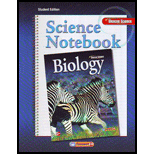
Concept explainers
(1)
To determine:
Different levels of
Introduction:
The study of life is known as biology.Asstudy of life is a very broad topic, researchers and scientists have divided organisms into several levels of organizations for better understanding. These levels start from the smallest unit to the largest categories of life.
(1)
Explanation of Solution
In a biological hierarchy, an organism is the smallest unit. An organism belongs to a single species and members of a species make up the population. Many different populations of a particular region, which interact with one another make up a community. A community includes all the living organisms of that area.A community along with all the abiotic factors makes up an ecosystem.
Similar types of ecosystems make up a biome. One biome may contain different ecosystems, but the animals and plants living in one type of biome have similar adaptations. All the biomes on earth make up the biosphere.
Hence, the level of biological hierarchy from largest to smallest is:
- Biosphere
- Biome
- Ecosystem
- Biological community
- Population
(2)
To compare:
The terms given in the table.
Introduction:
In the ecological study, an organism is the smallest unit. In an ecosystem, one organism has its niche and role. All the organisms in an ecosystem share an importantandrepresent different types of interactions, such as commensalism, mutualism, parasitism, and predation.
(2)
Explanation of Solution
The comparison between habitat and niche is given as follows:
| Habitat | Niche |
| 1. It is the physical space occupied by an organism. 2. It can be shared among species, so, many different species have the same habitat. | 1. It is the functional space of an organism. 2. A niche cannot be shared among species and it is unique to onespecies. |
The comparison between biotic and abiotic factors is given as follows:
| Biotic factors | Abiotic factors |
| 1. It refers to the living entity of an ecosystem. 2. They are dependent on abiotic factors for their survival. 3. Biotic elements also affect the survival of other living things. 4. They have the ability to adapt to the changes in the abiotic factors. 5. It includes plants, animals, microbes, etc. | 1. It refers to the nonliving entity of an ecosystem. 2. As these are nonliving, they do not depend on biotic elements. 3. They can affect the survival ofbiotic elements. 4. They cannot adapt as per the changes in the biotic factors. 5. It includes temperature, climate, water, soil, pH, salinity, etc. |
Symbiosis can be defined as the close relationship between two different organisms, which belongs to the same community. In this type of relationship, at least one of the species is benefitted. It is basically of three types, commensalism, mutualism, and parasitism.
| Commensalism | Mutualism | Parasitism |
| Commensalism is a relationship in which one organism is benefitted and the other organismsare neither harmed nor benefitted. Example: Birds that live in the hollow of a tree. In this case, the tree is not benefitted or harmed, but the bird gets shelter and protection. | Mutualism is a relationship, in which both the organisms involved are benefitted. Example: Bees and flowers. The bees get nectar from flowers, and in return, they act as a pollinator and help in the reproduction of plants. | Parasitism is a relationship, in which one organism is benefitted (parasite) and the other is harmed (host). Example: Tick or flea that lives on the skin of dogs are examples of |
Predation: It is an act of killing and consumption of other organisms as a primary food source. For example: hunting of a deer by a lion.
Additional Science Textbook Solutions
Campbell Essential Biology (6th Edition) - standalone book
Concepts of Genetics (11th Edition)
Genetic Analysis: An Integrated Approach (2nd Edition)
Campbell Biology: Concepts & Connections (9th Edition)
Brock Biology of Microorganisms (15th Edition)
Laboratory Experiments in Microbiology (11th Edition)
 Human Anatomy & Physiology (11th Edition)BiologyISBN:9780134580999Author:Elaine N. Marieb, Katja N. HoehnPublisher:PEARSON
Human Anatomy & Physiology (11th Edition)BiologyISBN:9780134580999Author:Elaine N. Marieb, Katja N. HoehnPublisher:PEARSON Biology 2eBiologyISBN:9781947172517Author:Matthew Douglas, Jung Choi, Mary Ann ClarkPublisher:OpenStax
Biology 2eBiologyISBN:9781947172517Author:Matthew Douglas, Jung Choi, Mary Ann ClarkPublisher:OpenStax Anatomy & PhysiologyBiologyISBN:9781259398629Author:McKinley, Michael P., O'loughlin, Valerie Dean, Bidle, Theresa StouterPublisher:Mcgraw Hill Education,
Anatomy & PhysiologyBiologyISBN:9781259398629Author:McKinley, Michael P., O'loughlin, Valerie Dean, Bidle, Theresa StouterPublisher:Mcgraw Hill Education, Molecular Biology of the Cell (Sixth Edition)BiologyISBN:9780815344322Author:Bruce Alberts, Alexander D. Johnson, Julian Lewis, David Morgan, Martin Raff, Keith Roberts, Peter WalterPublisher:W. W. Norton & Company
Molecular Biology of the Cell (Sixth Edition)BiologyISBN:9780815344322Author:Bruce Alberts, Alexander D. Johnson, Julian Lewis, David Morgan, Martin Raff, Keith Roberts, Peter WalterPublisher:W. W. Norton & Company Laboratory Manual For Human Anatomy & PhysiologyBiologyISBN:9781260159363Author:Martin, Terry R., Prentice-craver, CynthiaPublisher:McGraw-Hill Publishing Co.
Laboratory Manual For Human Anatomy & PhysiologyBiologyISBN:9781260159363Author:Martin, Terry R., Prentice-craver, CynthiaPublisher:McGraw-Hill Publishing Co. Inquiry Into Life (16th Edition)BiologyISBN:9781260231700Author:Sylvia S. Mader, Michael WindelspechtPublisher:McGraw Hill Education
Inquiry Into Life (16th Edition)BiologyISBN:9781260231700Author:Sylvia S. Mader, Michael WindelspechtPublisher:McGraw Hill Education





